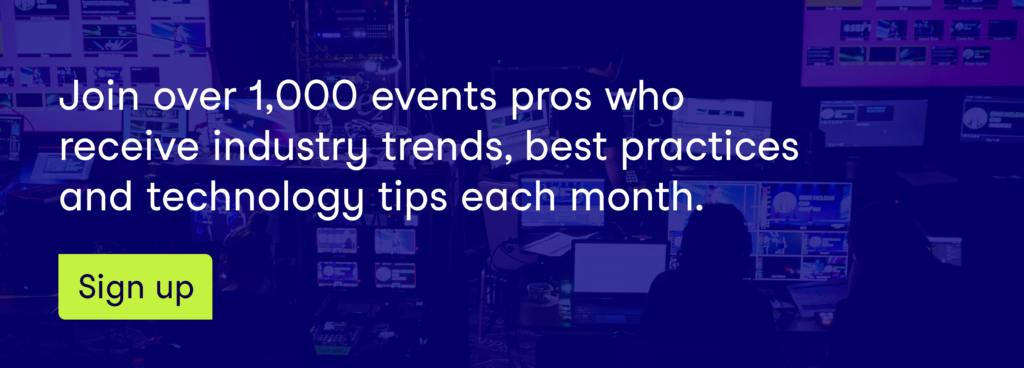At this point in our post-pandemic world, none of us are strangers to virtual events. From all-company meetings to virtual fundraisers to livestreams of in-person concerts, galas and more, we’ve all gotten pretty comfortable with watching events from the comfort of our own couches.
But when it comes to producing your own virtual event, lots of folks are still in the dark. And that’s okay — we’re here to help! Even if you’re planning a return to in-person events, the truth is that a virtual component is no longer optional. Allowing attendees to engage remotely expands your reach, makes your event more accessible, and helps you spread your message to those who may not have otherwise received it.
So after partnering with SmashFly Technologies to stream their event, Transform Virtual™, we caught up with their Event Marketing Manager, Shannon Pierce, for her expert insights on how to plan a virtual event successfully. Here’s what she had to say.
How to Host a Virtual Event in 7 Easy Steps
1. Getting started
The first step in hosting a successful virtual event is to determine its theme and content. Branding and visual communication is one of the most important factors to consider as you start planning, and will determine all of your event messaging, speakers, marketing strategy, and more.
So start by outlining your goals and budget. What are you hoping to accomplish with your event, and what metrics will you measure to define your success? From there, outline the main talking points and tone you want your event to take.
For SmashFly, they wanted to leverage the success of a recent in-person event in an effort to continue to engage their audience.
“We hosted a super successful in-person conference – SmashFly Transform™ – and it created so much buzz we knew we had to do it again. The only problem was cost. In-person events can be incredibly expensive. We wanted to keep the momentum of Transform going and continue growing this community, but can we get everyone together virtually and still have a great event? Turns out you can!
Transform Virtual™ was branded the same, the virtual experience was just like our livestream experience from the Transform event and the content was presented by practitioners so it’s all peer-to-peer learning (same concept that was so well received at our in-person event).”
2. Outline your content
Once you have a general sense of what you’d like your event to look like, it’s time to get down to brass tacks. What kinds of content will you include in your event?
Just as with any event, your content should include a mixture of different presentation formats. This can include keynote presentations, breakout sessions, and panel discussions. And as Charlie Kennedy reminded us in another recent panel discussion, virtual events come with their own sets of challenges when it comes to programming. He says:
“We have to think of this like we’re producing a TV show. We have a much shorter amount of time to keep the viewer’s attention. Whereas in a ballroom, we always knew where people were, if they were paying attention or not — it’s a whole new challenge when we can’t see our audience.”
— Charlie Kennedy, Founder & Creative Director, Show Up Event Consulting
So it’s not enough to prepare a Powerpoint presentation and call it a day. We have to work a lot harder now to keep audiences engaged while they’re distracted with everything going on behind their computer screen. So think about how you might educate your audiences with interesting speakers, while also keeping them entertained and present. Here are just a few ideas to get you started:
- Offer a panel discussion with a diverse range of voices, with the option for attendees to submit their own questions
- Host a DJ set between speakers to drive energy
- Run polls or quizzes during or between speakers
- Organize a contest that attendees can vote on during the event (like this chef and mixologist competition at a Marriott-hosted event a few years ago)
- Get people out of their seats with a virtual dance party
3. Choose your format
Next, it’s time to choose a format (or “container”). Where will your virtual event live? How will your audience engage with your content?
These days, there’s no shortage of options for hosting an event remotely. Facebook, Instagram, Youtube and LinkedIn all offer live streaming options, giving audiences the ability to react and comment on the content they’re viewing.
Other platforms like Zoom or Vimeo offer a bit more privacy if you’re looking to make your event feel exclusive, or if you’d prefer to pre-record all of your content beforehand. Here, attendees might be able to interact with each other in the chat, or click on links for more information about your brand. These platforms also offer accessibility features like closed captioning or alternative languages, making your event more approachable to more people.
For a fully immersive experience, consider licensing a virtual events platform like Hubilo, Hopin or cvent. While costly, these all-in-one platforms support virtual networking, Customer Relationship Management (CRM) integration, and built-in interactions that drive engagement through the roof.
Whatever platform you choose, make sure you do plenty of research to understand how the tech works before the big day. (We know this piece of the puzzle can feel like a lot — so we’re always here to support you with the right technology and help you produce a seamless event! Get in touch to learn more.)
4. Secure (and prep) your speakers
Once you’ve outlined your content and platform(s), do some research to determine who the best speakers would be for your event. Perhaps it’s a client, or someone who works for your company. Or maybe it’s a highly-regarded expert who can speak to your event topics. Going big? Maybe you book a big-name celebrity as your keynote speaker!
When your outreach is complete and you have commitments from your speakers that they’re willing to participate, the Mainstream team always recommends scheduling a “dry run” tech check call with speakers before the event (or pre-recording). This ensures they are comfortable with the recording software, have adequate internet speeds and proper lighting. It will also give you a chance to control the background of the speaker to avoid distracting images or bad patterns.
Shannon offers this helpful advice:
“Honestly, the hardest part about planning a virtual event is scheduling your speakers, internal stakeholders and your production team for all the calls that it takes to pull the event together.
Our goal was to have 3 calls with each speaker: first the kick-off call to introduce the event and discuss a topic, next a dry run to walk through the entire presentation and make content suggestions, and then the final session call as if they were presenting live.”
Set expectations with your internal stakeholders that they will need to be flexible to accommodate your speaker’s schedules during the weeks leading up to the event.
5. Promote your event
What’s an event with no attendees?
Before your big day, be sure to include marketing in your overall event strategy. It starts with a strong landing page where audience members can find more information and register.
From there, schedule promotional email blasts and social media posts. For larger events, maybe you’ll even reach out to local media to promote and help cover the event. Here’s what SmashFly did:
“In order to get the word out about Transform Virtual™ we used email marketing, mobilized our internal sales reps and customer success team to send personal invites to their accounts, social media including Twitter and announcements to our Transform Community Facebook Group, retargeting ads and partner marketing. Our content team was constantly writing tweets and sending them out internally and to our speakers to activate as many people as we could on social and make is super easy for them to spread the word.
One of the biggest differences between an in-person event and a virtual event is that the bulk of your registrations for a virtual event come the week prior to your go-live date. We heavily exceeded our registration goals, but over 50% registered in the last 4-5 days (including the day of!). It’s always a little stressful waiting for your pre-promotion campaigns to convert into registrants.”
Even though you may get a slew of registrations the week before the event, it’s still important to keep audience members engaged before you hit the “Go live” button. Send regular reminders to registrants with a sneak peek at what they can expect, and instructions for how to join on the day of the event.
6. Run your show
Congratulations! You’ve produced some exciting content with world-renowned subject matter experts. Whether you’re live or streaming pre-recorded content, the last step is to push “Start” on your event and engage with your audience in real time—by monitoring your social media outlets and responding to chats and Q&A during the event.
Think about what hashtags you might use to drive community conversation on social, and understand where your audience is spending the most time so that you can maximize their event experience and meet them where they are.
And if there are any questions that can’t be answered during your event, make sure you flag those too so that you can follow up with event attendees after the fact. No one likes to be left hanging!
7. Analyze, analyze, analyze!
Now that your event is over, it’s time to look at the data and see how it went. For SmashFly, they wanted to keep their audience watching the content as long as possible. Their average viewing time was about an hour, nearly twice the industry standard. Other points of data may include:
- Email open rate
- Total ticket sales (if paid), total registrations (if unpaid)
- Conversion rate
- Total audience size
- Average view time per audience member
- Engagement during broadcast (tweets, shares, comments, etc.)
With data in hand, you can understand how to make your next event even more successful.
Final Thoughts
With proper planning, SmashFly knocked their first virtual event out of the park. SmashFly leaves us with this wisdom:
“Besides the obvious need to deliver great content and work with your speakers very closely on their presentation development, make sure you have an awesome production partner if you plan to host a virtual event. You content could be awesome, but your production partner can help make the viewing experience more dynamic and interesting.”
If you have any further questions or would like Mainstream to produce your virtual event, feel free to get in contact with us! We’d love to share our expertise with you or even handle your entire virtual event from start to finish.
A previous version of this post was originally published on 7/28/17 by Brian Ciaccio.




I wasn’t aware that you can conduct virtual events through Vimeo, I wonder if they will be easy to navigate
The author provided clear and concise steps for organizing and executing a successful virtual event. I particularly appreciated the emphasis on engagement and audience interaction, which is crucial for creating a memorable experience for attendees. The tips on selecting the right virtual event platform and creating engaging content were also very helpful.
The author’s in-depth explanation of the various elements involved, including pre-production, live production, and post-production, provided valuable insights and practical tips. What I particularly appreciated was how the article emphasized the importance of keeping the audience engaged and creating a sense of community, even in a virtual setting.
It’s clear that Mainstream Chicago has a knack for making the digital realm feel as engaging as the real thing. Thanks for sharing these valuable insights!